Original link: https://www.hellobtc.com/kp/du/06/3959.html
Author: joyce / Source: Vernacular Blockchain

Author | Joyce
Produced | Vernacular Blockchain (ID: helloBTC)
From $250 billion in December 2021 to $106 billion today, in just half a year, the TVL (Total Value Locked) of all on-chain ecosystems in the entire industry has dropped by nearly 60%.

Figure: Changes in the total TVL data of the crypto industry, June 7, 2022, via DeFiLlama
Coupled with the recent collapse of the two biggest hot spots in the Luna Ecology and StepN markets, the proper bear market rhythm is undoubtedly.
In a bear market, where is the money in the market? We analyzed the top 50 wallet addresses on DeBank, checked the asset trends of these giant whales, and found out the top 8 DeFi platforms that these 50 giant whales pledged or preferred for liquidity mining during the current bear market stage.
01
Convex
Convex is currently the most popular DeFi protocol among giant whales.
Convex is a rig pool that mainly helps the liquidity providers of Curve (one of the largest DEXs in DeFi) and CRV holders to maximize their profits.
At present, Convex has nearly 100 pools online. In addition to various types of stable coins, there are BTC anchor coins, ETH and other small coins, but for giant whales, they prefer stable coins and mainstream coins. Mining.
Of course, there are also a lot of CRV mortgages. After all, in order to increase the right to speak in the Curve liquidity dispute, Convex has tried every means to attract users to mortgage CRV.
Judging from the current yield data on Convex’s official website, as the market goes bearish, the overall yield is much lower. The yield of the stablecoin portfolio ranges from 0.07% to 11.23%, and the yield of other small coins will be much higher, but The risk is also greater. The following is a case of two giant whales mining on Convex.
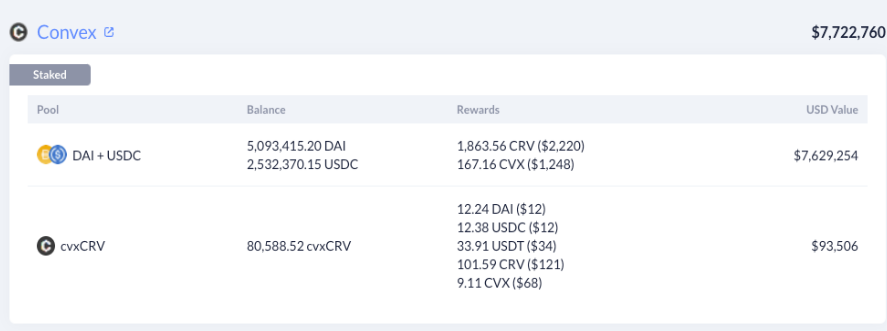
 Figure: Two cases of giant whales participating in Convex mining, from DeBank
Figure: Two cases of giant whales participating in Convex mining, from DeBank
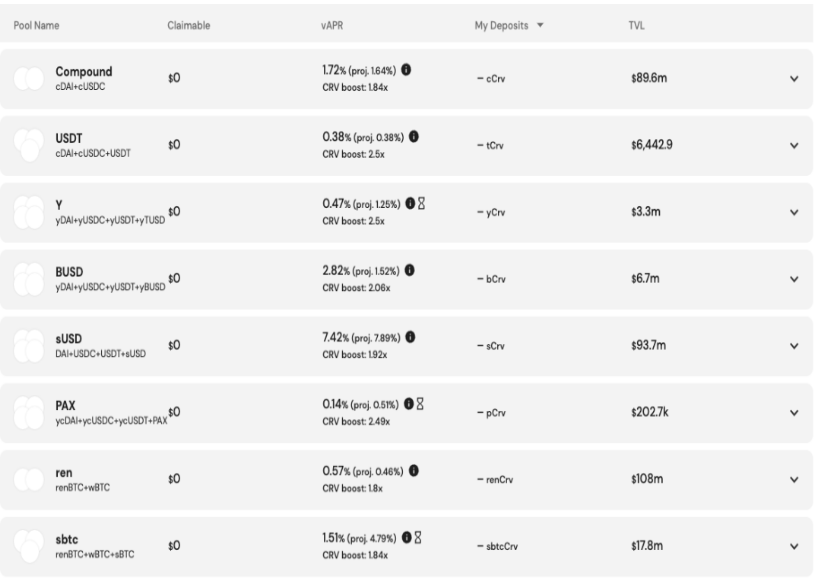
Figure: The yield and TVL data of some of Convex’s liquidity mining pools, from Convex’s official website
02
Curve
As mentioned earlier, Curve is one of the largest DEXs in DeFi, especially known for providing stable currency liquidity.
Although Curve’s TVL far exceeds that of Convex, ranking second only to MakerDAO, but from the perspective of the personal mining choices of these giant whales, the enthusiasm for mining on Curve is far less than that of Convex , and the amount of funds invested in mining is also relatively Relatively low, after all, the yield is really not high.
The giant whales mining on Curve either pledge CRV or use BTC’s anchor currency combination to mine. What should I say about the earnings in the bear market?

Figure: A case of combined mining with BTC anchor coins on Curve, from DeBank

Figure: Part of Curve’s liquidity mining pool income, from Curve’s official website
03
Aave
Aave is the leader of DeFi borrowing, a sound financial market, borrowing is a very important part of it.
Although they have entered the bear market, giant whales will still choose to put their assets in Aave. On the one hand, they mortgage their assets to obtain interest. On the other hand, they lend the required assets to other DeFi Dapps for mining . good business.
The interest rate of Aave’s mortgage assets is not high, which is equivalent to the bank’s current interest rate, but fortunately, the borrowing rate is not high, and when there are good arbitrage opportunities, it can still greatly improve the efficiency of the use of funds.
However, the interest rate is also floating. The current low interest rate indicates that the demand for loaned funds is not high. When extreme market conditions or very good arbitrage opportunities appear, the loan interest and the mortgage borrowing interest will increase accordingly.
For example, when extreme bargain hunting occurs, stablecoin interest may rise sharply. For example, every time BNB is renewed, the interest on lending BNB will also increase.
As the demand for funds increases, the rate of use of funds will naturally increase.
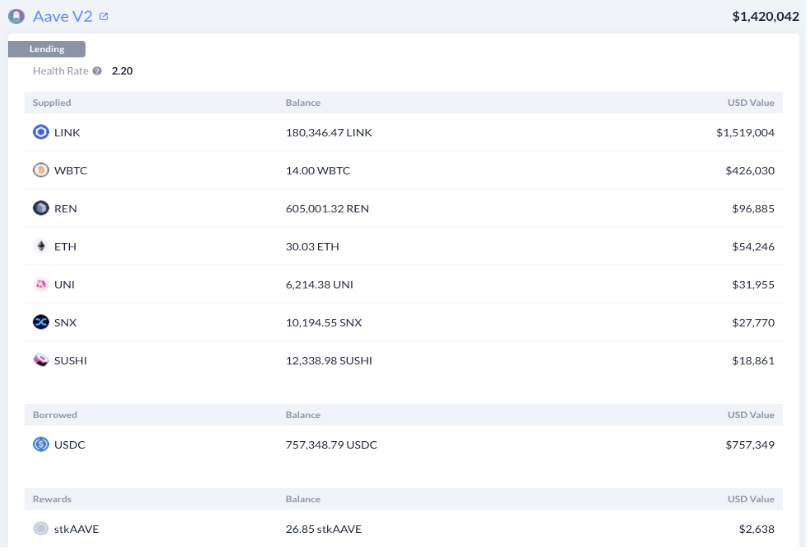
Figure: Aave borrowing case, from DeBank
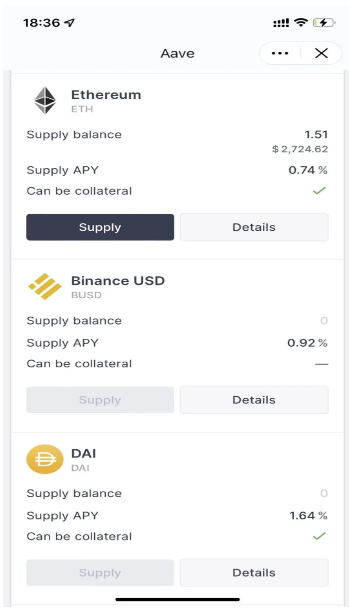

Figure: Details of the mortgage and loan interest of some of Aave’s assets, from Aave’s official website
04
Uniswap
As a blue-chip DeFi project and the top brand of DEX, Uniswap is naturally the best choice for many giant whales. However, from the perspective of the participation of the top 50 giant whales, the enthusiasm for Uniswap’s liquidity mining is far less than that of the bull market. After all, with the current If you want to mine with the current market conditions, the liquidity loss will be too large. It is better to go to Convex or Curve to participate in stablecoin mining to be safe and reliable.
In addition, the bear market Uniswap trading volume has shrunk a lot, and the income of liquidity mining mainly comes from a part of the transaction user fee. Therefore, when the trading volume is insufficient, the mining income will naturally be much lower.
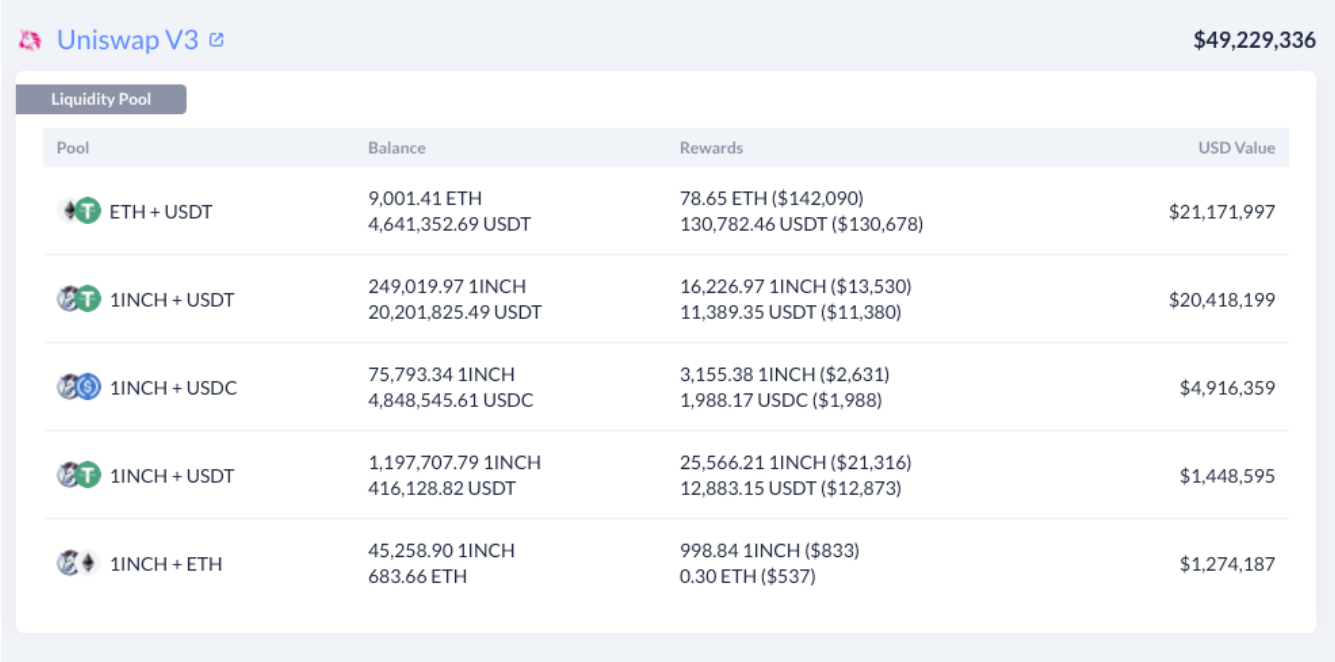 Figure: Uniswap liquidity mining case, from DeBank
Figure: Uniswap liquidity mining case, from DeBank
05
Maker
Although DAI is only an application of Maker, the current DAI has basically become synonymous with Maker.
At present, DAI has become the most important stablecoin in the crypto world with cryptocurrency as collateral .
The collateral for DAI can be more than 20 mainstream Tokens such as Ethereum. When you need a liquid fund, but don’t want to sell the Ethereum in your hand, you can mortgage the Ethereum as collateral in Maker, generate DAI, and use DAI to buy the assets you need.
It sounds a bit like borrowing, but the significance of stablecoins is much more than that. For all pricing and most payment scenarios in the crypto world, using stablecoins will be much less conflict than using volatile cryptocurrencies. Maker’s stable currency, DAI, is a stable currency completely built on the blockchain and does not need to rely on legal systems or any other trusted third parties .
For giant whales, choosing Maker is mainly used to mint DAI stablecoins. In this process, the fee for redeeming the collateral ETH is extremely low, and the annual interest for minting DAI with Ethereum mortgage is only 0.5%, so the cost of capital is quite low.
 Figure: The case of Maker’s mortgage on behalf of DAI, from DeBank
Figure: The case of Maker’s mortgage on behalf of DAI, from DeBank
 Figure: Maker’s various collateral minting DAI fees and entrances, from Maker’s official website
Figure: Maker’s various collateral minting DAI fees and entrances, from Maker’s official website
06
Frax
Friends who often read vernacular articles should be familiar with Frax. In “DeFi 2.0’s masterpiece, perhaps in the great player of Curve War” , we mentioned Frax, the leader of algorithmic stablecoins.
Pure algorithmic stablecoins such as ESD, BAS, and UST have collapsed one after another, and Frax, a partially mortgaged algorithmic stablecoin, has become the leading project of algorithmic stablecoins. And Frax seems to be getting stronger and stronger in the Curve liquidity war, and has now become the largest holder of CVX.
What does the largest holder of CVX mean?
CVX is Curve’s Token. Locking CVX can get veCRV. Holding veCVX means governance rights, 50% of Curve protocol transaction fees, and a multiple of CRV rewards.
Therefore, every protocol participating in the Curve liquidity war will acquire as much CRV as possible, so as to obtain the maximum possible increase multiple for storage users, which means more income, thus attracting more TVL.
At present, the income of Frax’s liquidity pools is relatively good. Compared with other protocol pools, the income is significantly higher. It is also a relatively good income for stablecoin portfolios in a bear market.
 Figure: Frax liquidity pool mining case, from DeBank
Figure: Frax liquidity pool mining case, from DeBank
 Figure: Income and TVL of Frax’s liquidity pools, from Frax’s official website
Figure: Income and TVL of Frax’s liquidity pools, from Frax’s official website
07
GMX
GMX is a decentralized and perpetual DEX platform. At present, the operations of giant whales in GMX are mostly low-leverage hedging, or mortgage GMX, GLP and other platform tokens to obtain income.
At present, the yield of mortgage GMX and GLP in GMX is not bad, reaching 24.6% and 39.1% respectively, which is a good income under the current market conditions. Therefore, among the top 50 giant whales, many giant whales choose to participate in GMX Token pledge to obtain income.
 Figure: GMX low leverage and token pledge case, from DeBank
Figure: GMX low leverage and token pledge case, from DeBank
08
Beefy
Beefy is also a machine gun pool, a decentralized multi-chain revenue optimization platform. The revenue of the above pools is indeed exaggerated compared to other DeFi protocols, especially for some small currency liquidity pools, the revenue can reach hundreds of times, but , it is estimated that high returns will be difficult to sustain in this market.
At present, the operations of giant whales in Beefy are mostly a combination of stable coins, or a combination of stable coins and mainstream coins. In this situation, it is more cautious to participate in the mining operation of the liquidity pool.
However, even with stablecoin mining, it seems that Beefy’s revenue is much higher, which is why Beefy has risen rapidly as a new platform in just a few months.
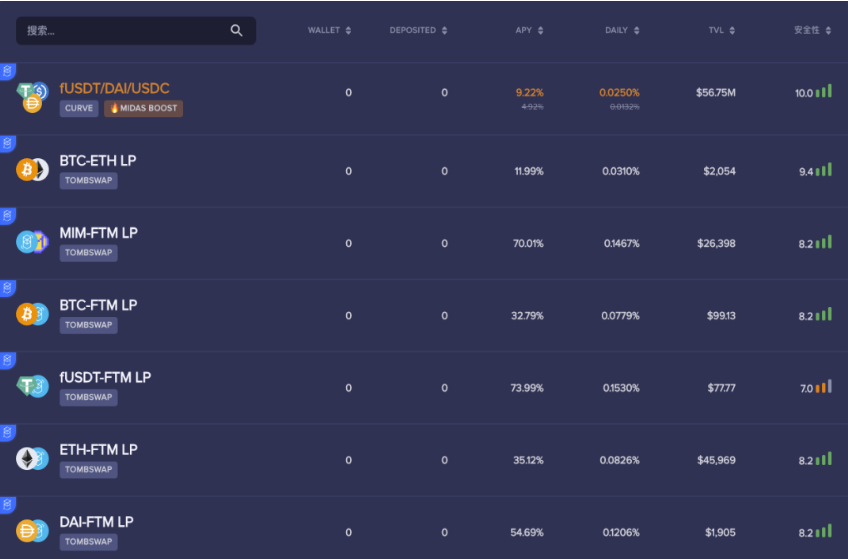 Figure: The income and TVL situation of each Beefy pool, from Beefy official website
Figure: The income and TVL situation of each Beefy pool, from Beefy official website
09
summary
Of course, the above eight protocol platforms only enumerate the preferences of the top 50 giant whale users on DeBank for DeFi protocols. The sample size is not too large and may not fully reflect the facts.
However, from the actions of these giant whales, we can somewhat see the more popular mining platforms at present, and at the same time, we can also filter out some more valuable DeFi mining information.
However, the bear market is long, and the smartest money may have already been exchanged for stablecoins or mainstream coins and stored in cold wallets, waiting for the bear market to slowly buy bottoms, and then wait for the next bull market to come.
In any case, asset allocation is essential in the process of financial management. In the case of ensuring the safety of assets as much as possible, participate in stablecoin or mainstream currency mining, so that your assets can slowly increase in value, why not for what~
The bear market is coming, where are your assets? Let’s chat.
This article is reprinted from: https://www.hellobtc.com/kp/du/06/3959.html
This site is for inclusion only, and the copyright belongs to the original author.